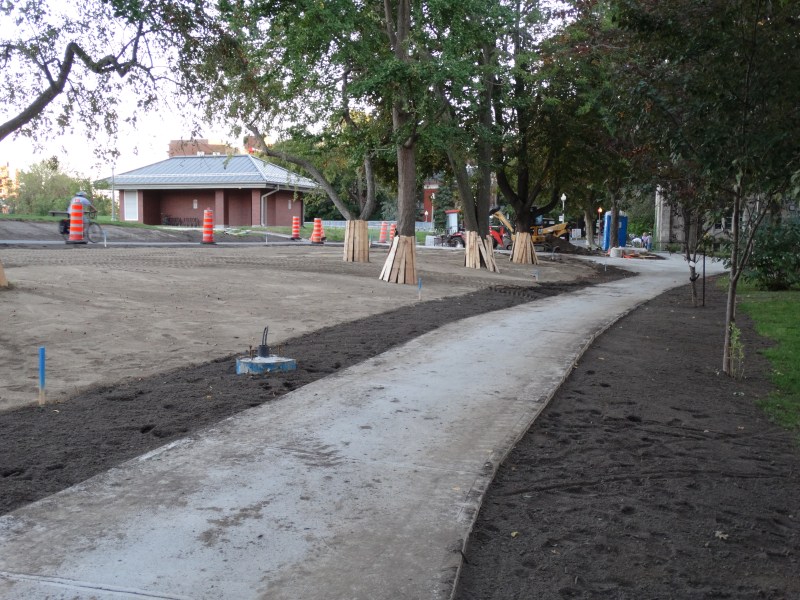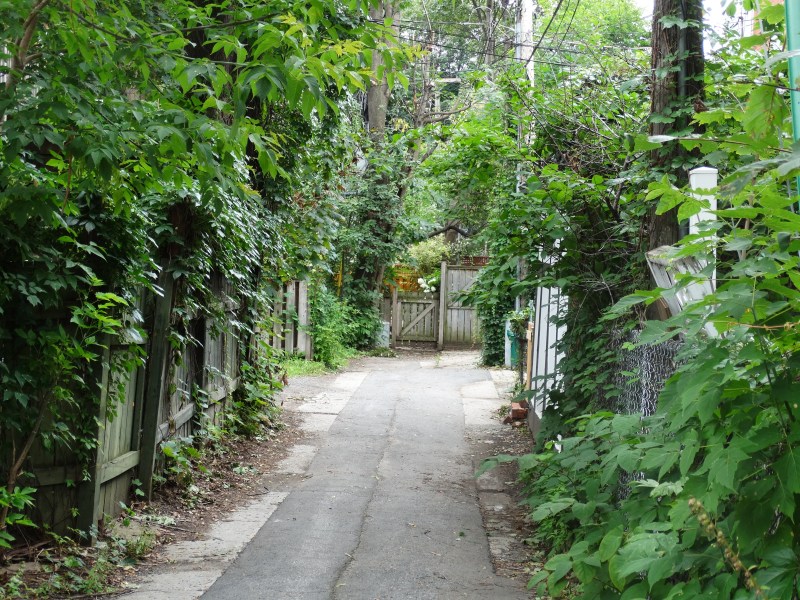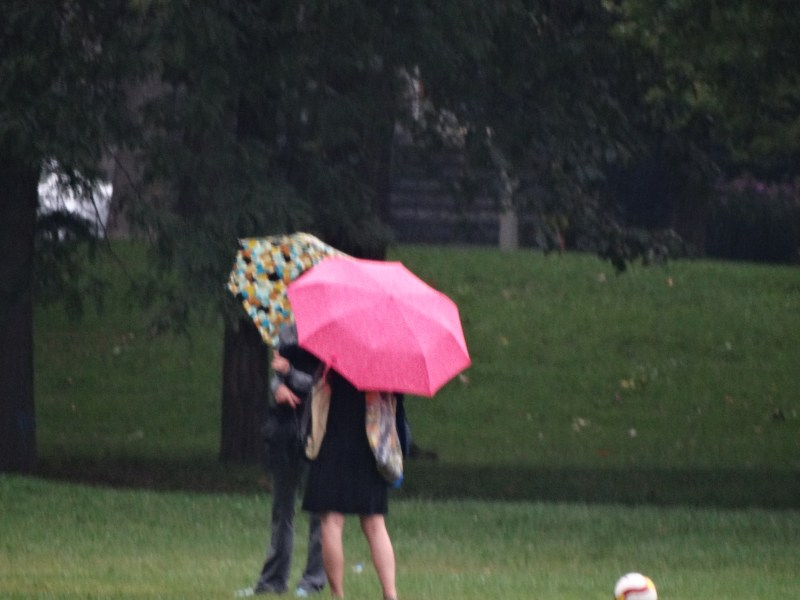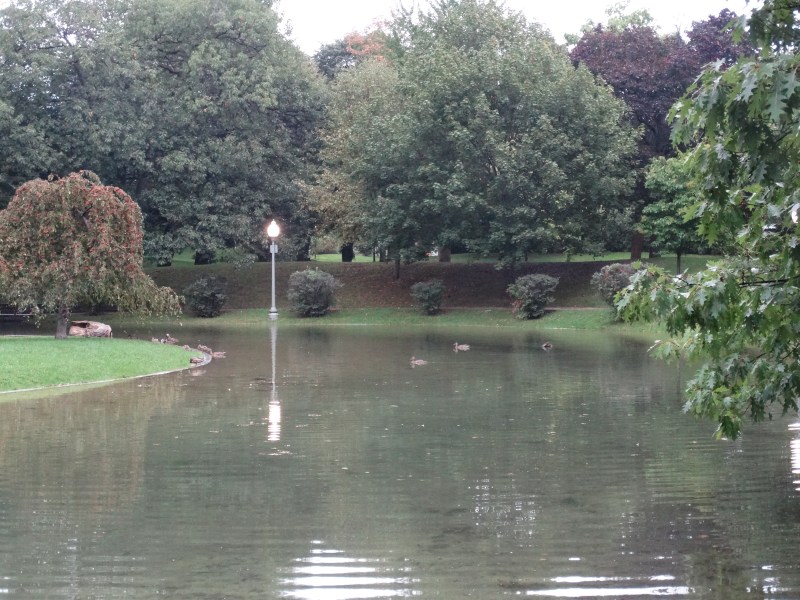Our walk through Westmount Park during the last day of Summer.
Westmount Park – Construction
Westmount Park
Westmount Park
Westmount’s Lanes
A version of this article appeared in Westmount Magazine:
http://www.westmountmag.ca/exploring-westmounts-lanes/
“Nothing will make you feel more like a true insider than turning the corner of a perfectly average street and finding yourself in a hidden garden lane. – Fodor’s Travel, 2007”
“This is lost land – the last known deed was dated 1933 and the owner cannot be located.” Those were the comments from our notary as she put her office seal on our newly-minted Certificate of Location as we were finalizing the purchase of our Westmount home.
The “lost land” she was referring to was a seven-foot wide, unpaved lane that intersects a dead-end street next to our house, running about half the length of a city block. It’s an area where tree seeds have germinated into saplings and wild plants co-mingle with flowers seeded from former gardens outside the confines of traditional landscaping. That was our first introduction to Westmount’s lanes.
Shortly after moving in, a large dog became part of our family; being our first dog, I quickly learned that they need to be walked – a lot! Westmount’s lanes became the perfect areas for our long walks. It is not uncommon to stroll for nearly an hour and not encounter a single soul. Aside from the modern asphalt paving, these are areas where time seems to stand still.
Originally, these lanes had several uses. They were former delivery areas for coal and ice, in fact disused coal chutes and ice delivery doors are still evident along the sides of many buildings. They were also back entrances to houses as evidenced by crumbling stairs leading to back doors that haven’t been opened in decades.
In addition, they were used as pathways for horses; one can still see former 19th-century coach houses along their paths.
For example, the lanes off Stayner have several former coach houses that are currently used as either garages or accommodation. Today, they are a quiet refuge from modern traffic. A place where butterflies, birds and a host of insects make their home among the choke cherry bushes, wild grapes and crabapples that line their paths.
There are several lanes that one can discover in Westmount. One won’t find them on any city maps. A few have names: the lane running parallel to the CPR tracks off Abbott is called Riverview. The lane joining Clarke and Greene has a sign with the words Love Lane.
Some lanes are all that is left from former manufacturing enterprises. For example, a former service lane north of de Maisonneuve that joins Metcalfe and Melville was used, in the 1920s, by the Canada Bread Company Ltd, now part of Mexico’s Grupo Bimbo, S.A.B. de C.V, when their plant was located at 315 Melville, formerly named Elgin.
The well-known Arlington lane running north from Sherbrooke was a portion of a former First-Nations’ path originating at Bethune, traversing west through the park, going north between what is now Belmont and Lansdowne, and ending on the mountain.
Arlington Lane has been described as a place where one can see “Westmount’s tidy back yards, in particular, a house with a wrought-iron gate and flower-filled gargoyles.” Sadly, that house no longer has its charming features. There are, however, beautiful old glass block windows as well as old garage doors off Ingleside lane that still have their original antique brass hardware.
Finally, it’s a comforting thought that there are still places where one can wander through timeless paths and reflect that what is observed was formerly unknown except to you! This is the gift the lanes impart to one’s body and soul by appreciating all that Westmount’s Terra incognita have to offer.
Westmount Park – Late Summer Morning
Westmount Park’s Hawthorn Trees
Have you noticed the tall circular concrete planter near the children’s playground? One can easily overlook it; however, this summer the city has adorned it with a blanket of red Impatiens.
I sometimes wondered why the planter is so high until looking closely at the four small trees it contains – their branches are covered with 5 cm spikes! These are Midland Hawthorns (Crataegus laevigata) – commonly known as English Hawthorns (a member of the rose family).
The name “hawthorn “is derived from Old English hagathorn – “hedge thorn” and describes their dark coloured fruit (“haws”) that appears late in the summer.
In northeast Ireland, these trees associated a wide array of folklore. Here they are called “Fairy Thorns” or by an older name “Gentry”. The latter also refers to fairies that were known as “The Gentry”.
Villagers would leave offerings of milk and honey and, in return, their “tiny music” was played in the evenings.
In Britain, they are regarded as the “unluckiest of trees”. In fact, Brehon (ancient Irish) laws made it unlawful to cut down a Hawthorn or damage its branches.
The belief that back luck follows damaging Hawthorns still exists. For example, a multi-million pound highway bypass, constructed in County Clair, was reconfigured to circumvent a Hawthorn in its original path.
Finally there is an interesting story that relates to construction of the DeLorean car factory near Belfast. There was a Hawthorn growing on the site and workers, despite direct orders, refused to cut it down. The tree was well-known locally and villagers told stories of the “wee folk” that left their footprints near the area. One day; however, the tree was gone – believed to be cut down by the foreign construction manager. From that day on, the factory was plagued with misfortune, some were convinced it was “cursed”. The factory closed in 1982 leaving thousands of workers without jobs.
Charming folklore or truth – perhaps somewhere in between?
“It may be so, and it may be not, but if we tell our children we have heard it is so, perhaps we shall see fewer primroses and daises and buttercups scattered along roads, to be trampled by iron-shod feet..”. (The Irish Naturalists’ Journal (1929))
















